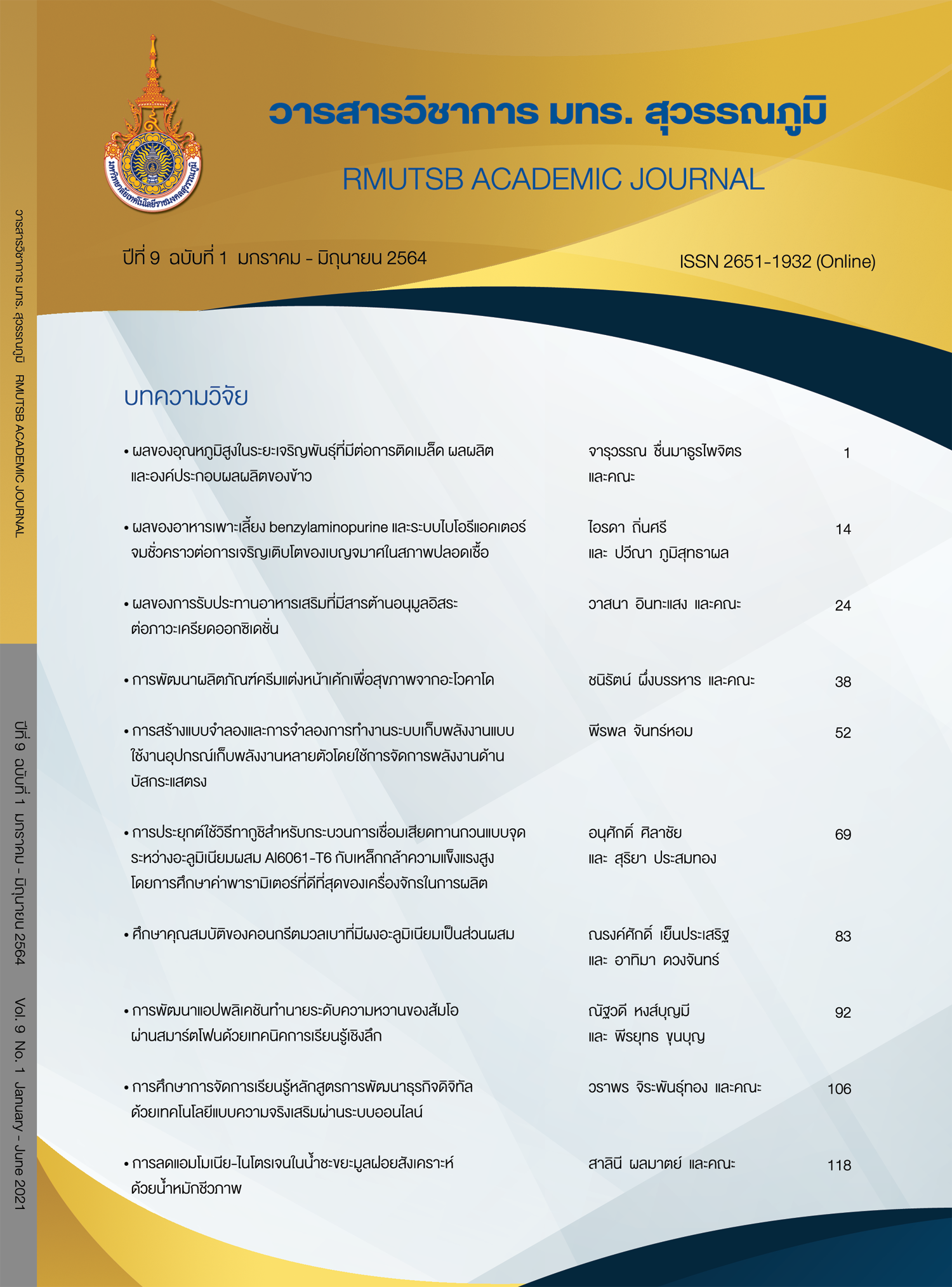Development of an application for forecasting the sweetness of pomelo on smartphone using deep learning technique
Main Article Content
Abstract
The objectives of this research were 1) to develop a pomelo sweet forecasting model using deep learning technique, 2) to develop an application for forecasting pomelo sweetness level for using on smartphone with android operating system, and 3) to assess the satisfaction of the application. This research was conducted by collecting 600 sample images of four pomelo types such as sweet Khawtaengkwa, unsweetened Khawtaengkwa, sweet Thakhoi and unsweetened Thakhoi. The sample images were analyzed and generated classifier models using a deep convolutional neural network. The results showed that the model of the convolutional neural network had a high efficiency, which was able to classify pomelo sweetness levels with the average accuracy of 97%. Therefore, this model was used to develop a user interface for a smartphone application, whereby the application ran the model through a series of instructions to analyze the sweetness levels of the pomelo images. The performance evaluation showed that the application was able to classify images and the sweetness levels of pomelo with average accuracy of 81.25%. The results of the system satisfaction assessment by users were good level with an average of 4.19. The experimental results indicate that an application can classify effectively sweetness levels of pomelo with convenience and speed. In addition, it helps to promote sale and confidence for the products from pomelo farmers.
Article Details
Published manuscript are the rights of their original owners and RMUTSB Academic Journal. The manuscript content belongs to the authors' idea, it is not the opinion of the journal's committee and not the responsibility of Rajamangala University of Technology Suvarnabhumi
References
Achravittayakun, W. (2001). Growing pomelo. Bangkok: Kasetsarn Publishing. (in Thai)
Boonchuay, S., Amloy, S., & Preechaburana, P. (2018). Surface plasmon resonance refractometer based on smartphone platforms. Thaksin University Journal, 21(3), 124-131.
Butploy, N., & Boonying, S. (2020). Classification of Benjapakee Buddha amulets image by deep learning. RMUTSB Academic Journal, 8(1), 100-111.
Gaticaa, G., Bestb, S., Ceronic, J., & Lefranc, G. (2013). Olive fruits recognition using neural networks. Procedia Computer Science, 17(2013), 412-419.
Jmour, N., Zayen, S., & Abdelkrim, A. (2018). Convolutional neural networks for image classification. International Conference on Advanced Systems and Electrical Technologies (pp. 397-402). Tunusia: IEEE.
Kasemsin, W., & Yolai, J. (2020). The development of demonstration kit for intramuscular injection needle display via smartphone inventor application. RMUTSB Academic Journal, 8(1), 112-125.
Kauri, P., Kaleka, S., & Singh, C. (2017). Image analysis technique for automatic characterization of fruits and measurement the sweetness. International Journal for Research in Applied Science & Engineering Technology (IJRASET), 5(7), 954-964.
Kausar, A., Sharif, M., Park, J., & Shin, D. (2018). Pure-CNN: A framework for fruit images classification. International Conference on Computational Science and Computational Intelligence (CSCI) (pp. 404-408). USA: American Council on Science and Education.
Khairunniza-Bejo, S., & Kamarudin, S. (2011). Chokanan mango sweetness determination using HSB color space. Third International Conference on Computational Intelligence, Modelling & Simulation (pp. 216-221). Malaysia: Nottingham Trent University.
Liao, J., Cai, L., Xu, Y., & He, M. (2019). Design of accelerator for MobileNet convolutional neural network based on FPGA. IEEE 4th Advanced Information Technology, Electronic and Automation Control Conference (IAEAC 2019) (pp. 1392-1396). China: IEEE.
Lim, G., & Chuah, J. (2018). Durian types recognition using deep learning techniques. IEEE Control and System Graduate Research Colloquium (ICSGRC 2018) (pp. 183-187). Malaysia: IEEE.
Manipphan, N. (2018). Growing and breeding pomelo. Bangkok: Promote the Career of Diamond Publishing. (in Thai)
Neonics. (2019). Brix refractometer. Retrieved 14 September 2019, from: http://www.neonics.co.th
Pattansarn, N., & Sriwiboon, N. (2020). Image processing for classifying the quality of the Chok-Anan mango by simulating the human vision using deep learning. Journal of Information Science and Technology, 10(1), 24-29.
Petagon, R., & Pantho, O. (2020). Drone for detecting forest fires using deep learning technique. Sripatum Review of Science and Technology, 12(1), 65-78.
Phisachphen, R., & Ongkhunarak, P. (2013). Operational research. Bangkok: SE-ED Ucation. (in Thai)
Pornpanomchai, C., Ja, A., & Supainun, K. (2016). Pineapple sweetness measurement by digital image processing. Proceeding of 2016 International Computer Science and Engineering Conference (ICSEC 2016) (pp. 638-646). Chiang Mai: Maejo University. (in Thai)
Sinha, D., & EI-Sharkawy, M. (2019). Thin MobileNet: An enhanced MobileNet architecture. IEEE Annual Ubiquitous Computing, Electronics & Mobile Communication Conference (UEMCON) (pp. 280-285). USA: IEEE.
Waes, C., Baert, J., Carlier, L., & Bockstaele, E. (1998). A rapid determination of the total sugar content and the average inulin chain length in roots of chicory (Cichorium intybus L.). Journal of the Science of Food and Agriculture, 76(1), 107-110.


